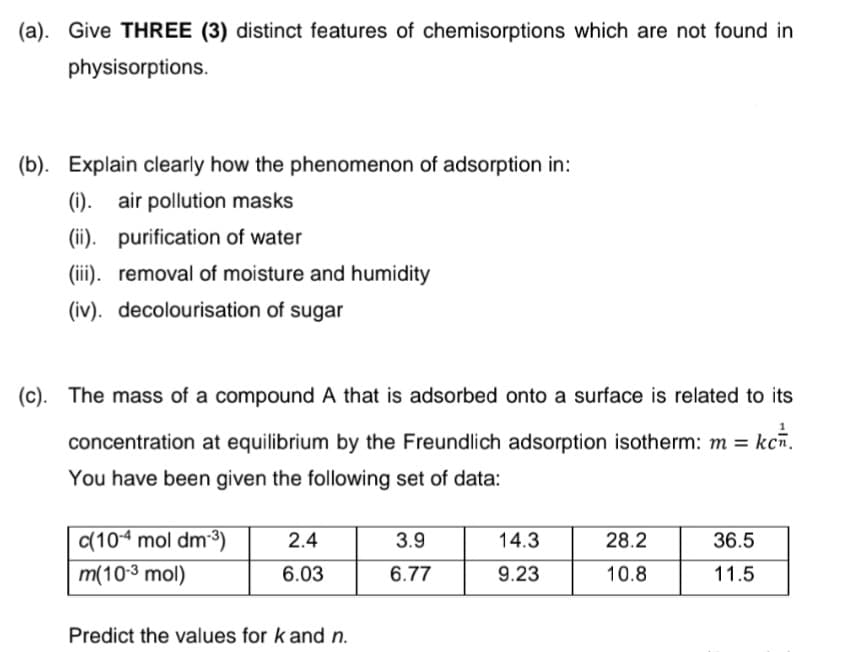The mass of a compound A that is adsorbed onto a surface is related to its concentration at equilibrium by the Freundlich adsorption isotherm: m = kcn. You have been given the following set of data: C(10-4 mol dm-3) 2.4 3.9 14.3 28.2 36.5 m(10-3 mol) 6.03 6.77 9.23 10.8 11.5 Predict the values for kand n
The mass of a compound A that is adsorbed onto a surface is related to its concentration at equilibrium by the Freundlich adsorption isotherm: m = kcn. You have been given the following set of data: C(10-4 mol dm-3) 2.4 3.9 14.3 28.2 36.5 m(10-3 mol) 6.03 6.77 9.23 10.8 11.5 Predict the values for kand n
Chemistry
10th Edition
ISBN:9781305957404
Author:Steven S. Zumdahl, Susan A. Zumdahl, Donald J. DeCoste
Publisher:Steven S. Zumdahl, Susan A. Zumdahl, Donald J. DeCoste
Chapter1: Chemical Foundations
Section: Chapter Questions
Problem 1RQ: Define and explain the differences between the following terms. a. law and theory b. theory and...
Related questions
Question
Kindly answer question c

Transcribed Image Text:(a). Give THREE (3) distinct features of chemisorptions which are not found in
physisorptions.
(b). Explain clearly how the phenomenon of adsorption in:
(i). air pollution masks
(ii). purification of water
(iii). removal of moisture and humidity
(iv). decolourisation of sugar
(c). The mass of a compound A that is adsorbed onto a surface is related to its
concentration at equilibrium by the Freundlich adsorption isotherm: m =
kcn.
You have been given the following set of data:
(10-4 mol dm-3)
2.4
3.9
14.3
28.2
36.5
m(103 mol)
6.03
6.77
9.23
10.8
11.5
Predict the values for k and n.
Expert Solution
This question has been solved!
Explore an expertly crafted, step-by-step solution for a thorough understanding of key concepts.
Step by step
Solved in 3 steps with 3 images

Knowledge Booster
Learn more about
Need a deep-dive on the concept behind this application? Look no further. Learn more about this topic, chemistry and related others by exploring similar questions and additional content below.Recommended textbooks for you

Chemistry
Chemistry
ISBN:
9781305957404
Author:
Steven S. Zumdahl, Susan A. Zumdahl, Donald J. DeCoste
Publisher:
Cengage Learning

Chemistry
Chemistry
ISBN:
9781259911156
Author:
Raymond Chang Dr., Jason Overby Professor
Publisher:
McGraw-Hill Education

Principles of Instrumental Analysis
Chemistry
ISBN:
9781305577213
Author:
Douglas A. Skoog, F. James Holler, Stanley R. Crouch
Publisher:
Cengage Learning

Chemistry
Chemistry
ISBN:
9781305957404
Author:
Steven S. Zumdahl, Susan A. Zumdahl, Donald J. DeCoste
Publisher:
Cengage Learning

Chemistry
Chemistry
ISBN:
9781259911156
Author:
Raymond Chang Dr., Jason Overby Professor
Publisher:
McGraw-Hill Education

Principles of Instrumental Analysis
Chemistry
ISBN:
9781305577213
Author:
Douglas A. Skoog, F. James Holler, Stanley R. Crouch
Publisher:
Cengage Learning

Organic Chemistry
Chemistry
ISBN:
9780078021558
Author:
Janice Gorzynski Smith Dr.
Publisher:
McGraw-Hill Education

Chemistry: Principles and Reactions
Chemistry
ISBN:
9781305079373
Author:
William L. Masterton, Cecile N. Hurley
Publisher:
Cengage Learning

Elementary Principles of Chemical Processes, Bind…
Chemistry
ISBN:
9781118431221
Author:
Richard M. Felder, Ronald W. Rousseau, Lisa G. Bullard
Publisher:
WILEY